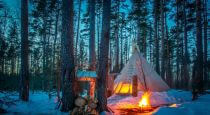Staying out during winter in extreme cold weather conditions can pose unique survival challenges. It won’t be easy, and it certainly won’t be pleasant. You might find yourself falling through ice or your car stopping in the middle of the wilderness.
Whatever the cause is, it puts you in a stranded position. You have to be careful and prepared for survival. Like everyone’s favorite survival expert Bear Grylls once said – Improvise, adapt, overcome. So, learning a few valuable skills like creating your shelter, making a fire, and looking for food can save your life.
This is where we step in and provide you with the necessary survival skills and knowledge to protect yourself from the wilderness and its harsh cold. So, let’s dive right into it, shall we?
Finding Water
You might be wondering why finding water is essential when you’re surrounded by snow. Well, that’s because it’s not a good idea to eat snow for your survival.
It’s a common misconception that you can eat snow, but it drops your core body temperature. We can assure you, you don’t want that. Hence why finding water is crucial, and not to mention it’s tricky when you’re out in the cold.
Instead of directly consuming the snow, you have to melt it first and then drink it. To melt the snow, you’ll need either a pot, fire pit, or a stove.
Make sure to add a little water to the pot before melting the snow. The water will act as a starter and help it melt much faster.
No Pots, Fire, or a Stove?
In situations like this, what you can do instead is fill your canteen with some snow and put it in your jacket.
With the help of your body heat, the snow will start to melt. Remember, every time you take a sip, add a bit more snow. Refilling the canteen is vital as it will help to melt the snow faster.
However, do not add too much all at once as it can make the water cold and unsafe to drink.
Finding Food
As if it’s not challenging enough to find food during spring and summer, it’s even more limited in cold weather. There won’t be many leafy plants around you, and trapping insects won’t be possible either.
So, what can you do in this scenario? You might have come across expert instructions to learn how to track or trap animals. While that’s undoubtedly a good idea, realistically, it’s not so easy to pull off – particularly if you’re already hypothermic and exhausted.
It’s better to invest your time in finding winter edibles like rose hips, barberries, persimmon, maple sap, or chickweed. You can also fish if there’s a lake near you as well. Cleaning and prepping the fish to cook is also an important task. Check out The Nature Insider to learn more!
Keep in mind, not all plants are edibles and safe to eat. Some can cause serious health issues, so it’s best to be familiar with the edibles available in your area first.
Building a Survival Shelter
Building a shelter can help you survive much longer when you’re out and exposed to extreme cold. A standard shelter design like an A-frame or a lean-to-shelter will work just fine in freezing temperatures.
However, if you’re in a situation where there is plenty of snow and no leaves or sticks around, then have no fear! Snow itself is an excellent insulator, and you can use it to build yourself a warm survival shelter.
Here are a few shelters you can make easily:
- Snow Pits – If you have your sleeping bag, tarp, and pad, you’ll be able to sleep much more comfortably in the cold weather. You’ll have to dig into the snow to create a pit for your bed and make sure that the snow is packed down as well. Otherwise, your body heat will cause you to sink into the snow, which you have to avoid at all costs. This is where having a winter tent comes into play. Contrary to popular belief, winter tents don’t trap much heat. Instead, it helps to keep you warm by blocking the wind, which is essential for your survival.
- The Basic Snow Shelter – To build a basic snow shelter, you’ll first have to dig into a mound of snow to create a cave. This cave will provide a space for you to sleep in. If the snow isn’t deep enough to give you a stable structure for a roof, then you use pine boughs over the top instead.
- A Quinzee – Before we discuss how you can make a Quinzee, we’re obligated to tell you that it’s not the best choice for a cold-weather survival shelter. To build a quinzee, you have to create a pile of snow and then dig into it to make a cave. This takes a lot of time and energy, leaving you severely exhausted and cold. If the snow is low, then you use debris around you for shelter. Not only will it be easier, but you’ll be saving your energy as well.
- A Snow Cave – To build a cave shelter, you’ll have to make the tunnel entrance lower than the sleeping chamber. This method will help you survive and stay warm inside because warm air will rise and cold air will sink.
- A Tree Well Snow Shelter – If you don’t have a shovel with you and you’re running out of daylight, building a simple tree wall snow shelter would be your best bet at survival. Where there are evergreen trees, you’ll notice that the snow under it isn’t that deep. Step carefully towards the tree so that you don’t fall into the tree pit. Next, start packing down the snow to make a floor and walls. You can break off some branches to make yourself a roof.
Layers – The Key to Staying Warm
Unlike most people believe, the layering method doesn’t mean adding or removing clothes to adjust the temperature. If you think about it, it doesn’t sound practical.
Whenever you’re taking off your jacket to either add or remove a layer, you’re losing your body heat. Layering entails wearing clothes that will keep you dry and protect you from the elements to help trap heat.
Here are a few ways you can layer yourself:
- Base Layer – The purpose of a base layer is to draw the moisture away from your body, as in your sweat. And the fabric that’s perfect for this is wool. Try silk and synthetics, but never wear cotton as the base layer. Not only will it trap all the moisture, but it’ll also take a long time for it to dry.
- Mid Layers – This layer will help with your insulation. Think light and fluffy. You don’t want it to be too tight. Otherwise, it won’t be able to trap the air next to your body. Fleece is an excellent choice for good mid-layers. In case the weather is freezing, you’ll have to put on an extra mid-layer. You can go for wool jackets or a puffy down jacket. Both are excellent choices.
- A Shell – Lastly, the shell will be what protects you from the harsh, cold elements. It has to prevent the wind from carrying away your body heat and keep you from getting wet in the snow or rain. However, the problem with shells is that they’re not very breathable, so you can quickly start sweating. If you’re experiencing clear weather, then it’s wise not to wear the shell at all.
Making a Fire
It might sound challenging to build a fire when you’re surrounded by snow, the ground is wet, and so is the wood. Not only that, high winds can even blow your fire right out before the kindling has time to burn down.
Thankfully, there are ways to overcome these obstacles. Here are a few ways you can make a fire in the cold wilderness:
- Pack Down the Fire Pit – First off, there’s a high chance the snow under the fire will melt, which will cause the fire to sink. To avoid this, you’ll have to either pack it down with the snow or keep shoveling it away. We recommend doing the former.
- Create a Dry Platform – Don’t attempt to light the tinder directly under the snow. It will put out the sparks. What you can do instead is make your fire on a dry platform. If you don’t have an ax at your disposal, build a platform using alternating layers of branches.
- Dry Tinder and Kindling – If carrying dry tinder is a hassle, go for something small and straightforward – vaseline-coated cotton balls. They’ll burn for several minutes each. When there’s no dry tinder, you’ll have to make some yourself. Start by peeling the bark off of a branch with your knife. Next, rub your knife blade up and down the branch to get little shavings of dry wood. Keep in mind, you’ll need a lot of it to keep a fire going.
You’ll be needing dry kindling as well. Mostly it’s the outer layer of branches that get wet from the snow. So, all you have to do is use a knife to shave the bark off, and there you have it.
Final Thoughts
In conclusion, we’d like to say that it’s not exactly easy to survive in the wilderness, whether it’s a harsh cold or in the middle of a hot blazing summer.
We hope our survival guide helps you prepare for the harsh, cold elements you’ll face. It’s essential to have the right state of mind when you’re facing the wilderness. Don’t forget to bundle up with plenty of layers. Avoid staying out in the cold. Good luck!






































































